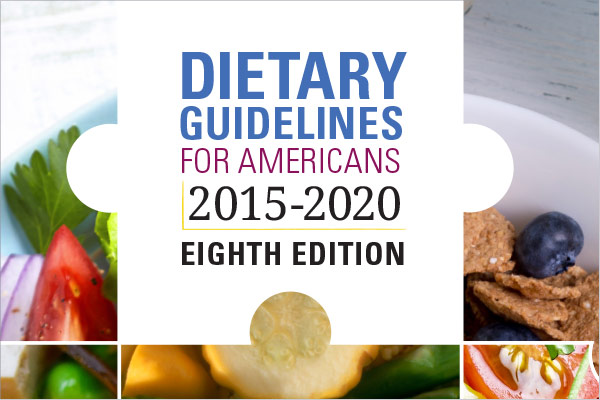Every five years the U.S. Departments of Agriculture and Health and Human Services publish the Dietary Guidelines for Americans. These guidelines are developed by an expert panel of nutrition and health professionals to help all Americans consume a healthy and nutritionally adequate diet. The 2015 – 2020 Dietary Guidelines for Americans outlines the following five recommendations:
- Follow a healthy eating pattern across the lifespan.
All food and beverage choices matter. Choose a healthy eating pattern at an appropriate calorie level to help achieve and maintain a healthy body weight, support nutrient adequacy and reduce the risk of chronic disease. - Focus on variety, nutrient density and amount. To meet nutrient needs within calorie limits, choose a variety of nutrient-dense foods across and within all food groups in recommended amounts.
- Limit calories from added sugars and saturated fats, and reduce sodium intake. Consume an eating pattern low in added sugars, saturated fats and sodium. Cut back on foods and beverages higher in these components to amounts that fit within healthy eating patterns.
- Shift to healthier food and beverage choices. Choose nutrient-dense foods and beverages across and within all food groups in place of less healthy choices. Consider cultural and personal preferences to make these shifts easier to accomplish and maintain.
- Support healthy eating patterns for all. Everyone has a role in helping to create and support a healthy eating pattern in multiple settings nationwide, from home to school to work to communities.
So what do these guidelines actually mean, and how can you use them to consume a healthy diet?
In the past, the dietary guidelines have focused on specific foods and nutrients that Americans should limit or increase. The current set of dietary recommendations is a bit different in the fact that the guidelines focus on a “healthy eating pattern.” Recognizing that people do not eat nutrients or specific food groups in isolation but within a complete diet that includes a variety of foods and forms, the expert panel developed “key recommendations” to help people create their own healthy eating pattern. The recommendations suggest types of foods that you should consume regularly but allow you to select foods that fit within your own culture, lifestyle and budget while maintaining a healthy body weight.
The following are the key recommendations that you should keep in mind when selecting foods as part of your healthy eating pattern.
- Include a variety of colorful vegetables. Eat dark green, red and orange colored vegetables (including starchy ones), and consume beans and peas.
- Include a variety of WHOLE fruit in your diet.
- Focus on whole grains. There are a variety of whole grains you can eat, including whole wheat, oats, brown rice, quinoa, millet, rye berries, bulgar, etc. Aim to make half the grains consumed in a day whole grains.
- Eat a variety of high protein foods. Studies suggest that people who consume more seafood, beans and peas, and nuts and seeds may have a lower risk for chronic diseases such as cancer. When selecting meat and poultry products, consider choosing lean meat and poultry more often and limiting the amount of processed meat and poultry products.
- Choose low-fat dairy products more often than full-fat dairy products.
- Include oils. When you cook, consider using oils, such as canola oil, on most days of the week or for most recipes. Use fats, like butter or shortening, occasionally.
If you follow the suggestions listed above, you should decrease the amount of saturated fat, added sugars and sodium in your diet. These are the only nutrients that the Dietary Guidelines for Americans specifically suggests limiting in your eating pattern.
The guidelines state that Americans should limit their consumption of saturated fat and added sugars to less than 10 percent of their calories per day. This means that if you consume a 2,000-calorie diet, you should eat no more than 22 g of saturated fat per day and no more than 50 g of added sugar per day. In order to meet these two specific recommendations, Americans should consider consuming less meat and poultry products, choosing low-fat dairy products more often, drinking less soda and sugar-sweetened beverages and drinking more water.
Additionally, the guidelines state that Americans should consume less than 2,300 mg of sodium each day. To reach this recommendation, Americans need to consider limiting their consumption of processed meats and poultry and packaged foods, and consuming more “whole” foods, such as fresh or frozen vegetables, for example.
It is important to remember that all foods can fit into a healthy eating pattern, and that the key recommendations described by the Dietary Guidelines for Americans are simply telling us which foods we should include regularly in our diet or eating pattern. For more information about the Dietary Guidelines, visit health.gov.